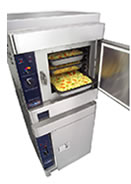Steam Cookers
Get Rebates,
Incentives & Services
Introduction

There are two basic categories of steamers on the market: pressureless (atmospheric) and pressurized. Each type is available in gas, electric, and direct-steam models. Pressureless steamers maintain the cooking compartment at close to atmospheric pressure; therefore, the door can be safely opened at any point to check the food. Pressurized steamers use a closed system to build pressure inside the compartments.
Steam cookers come in a variety of configurations including countertop models, wall-mounted models, and floor models that are mounted on a stand or cabinet-style base. A steam cooker may have one to four stacked drawers and are usually designed to accommodate a standard 12-inch by 20-inch pan.
Steam can be generated a number of ways: through a steam generator located within the compartment (usually produces steam at or slightly above the compartment pressure); by pouring boiling water directly into the cooking compartment before operation (otherwise known as “connectionless”); or through an external electric, gas, or service-steam powered boiler. In the case of connectionless steam cookers, water is manually added to the compartment and less steam leaves the cooking cavity during operation.
Technology Options
Commercial steam cookers provide an easy and fast way to prepare large quantities of food. Steam cookers are also one of the biggest opportunities for energy savings. Commercial steam cookers are typically operated from 8 to 12 hours per day, 365 days per year, and they also spend a significant portion of their operation time idling. Even in a busy restaurant, commercial steam cookers may be idle 75% of the time.
Energy-efficient steam cookers that have earned the ENERGY STAR offer shorter cook times, higher production rate, and reduced heat loss due to better insulation and more efficient steam delivery system.
Key ENERGY STAR Product Criteria:
Table 1: Energy Efficiency Requirements for Electric Steam Cookers
| Pan Capacity | Cooking Energy Efficiency | Idle Rate (watts) |
| 3-pan | 50% |
400 |
| 4-pan | 50% |
530 |
| 5-pan | 50% | 670 |
| 6-pan | 50% |
800 |
Table 2: Energy Efficiency Requirements for Gas Steam Cookers
| Pan Capacity | Cooking Energy Efficiency | Idle Rate (watts) |
| 3-pan | 38% |
6,250 |
| 4-pan | 38% |
8,350 |
| 5-pan | 38% | 10.400 |
| 6-pan | 38% |
12,500 |
Cooking Energy Efficiency is based on heavy load (potato) cooking capacity.
Key Technology Definitions
Cooking Energy Efficiency: The quantity of energy input to the food products, expressed as a percentage of the quantity of energy input to the appliance during the heavy-, medium-, and light-load tests.
Idle Energy Rate: The rate of appliance energy consumption while it is maintaining or holding at a stabilized operating condition or temperature.
Product Life: A typical commercial steam cooker is expected to last about 10 years.
Efficiency Benefits
EPA estimates that ENERGY STAR qualified commercial steam cookers save approximately 11,000 kWh (electric models) or 65 MBtu (gas models) annually. This equates to savings of $600 to $1500 annually on California end users’ utility bills. In addition to saving energy, ENERGY STAR qualified connectionless steam cookers also save water — 90% or more when compared with standard steam cooker models. ENERGY STAR qualified connectionless steam cookers can save approximately 170,000 gallons of water per year.
Energy-efficient steam cookers that have earned the ENERGY STAR offer shorter cook times, higher production rate, and reduced heat loss due to better insulation and more efficient steam delivery system.
Idle Energy Rate: The rate of appliance energy consumption while it is maintaining or holding at a stabilized operating condition or temperature.
Product Life: A typical commercial steam cooker is expected to last about 10 years.
Energy-efficient steam cookers that have earned the ENERGY STAR offer shorter cook times, higher production rate, and reduced heat loss due to better insulation and more efficient steam delivery system.
Electric Steam Cooker Example
| Cost-Effectiveness Example | |||
| Conventional Steamer | Energy Star Steamer | Savings | |
| Annual Energy Consumption | 15,287 kWh/Year | 4,219 kWh/Year | 11,068 kWh/Year |
| Annual Energy Cost | $1,987 (CA) $1,529 (National) |
$548 (CA) $422 (National) |
$1,439 (CA) $1,107 (National) |
| Lifetime Energy Cost (10 year life) | $19,870 (CA) $15,290 (National) |
$5,480 (CA) $4,220 (National) |
$14,390 (CA) $11,070 (National) |
| Annual Water Consumption | 175,200 Gallons | 4,219 Gallons | 170,981 Gallons |
| Annual Water Cost* | $1,171 | $88 | $1,083 |
| Lifetime Water Cost | $11,710 | $880 | $10,830 |
Gas Steam Cooker Example
| Cost-Effectiveness Example | |||
| Conventional Steamer | Energy Star Steamer | Savings | |
| Annual Energy Consumption | 999 Therms | 356 Therms | 643 Therms |
| Annual Energy Cost | $999 |
$356 |
$643 |
| Lifetime Energy Cost (10 year life) | $9,990 |
$3,560 |
$6,430 |
| Annual Water Consumption | 175,200 Gallons | 4,219 Gallons |
170,981 Gallons |
| Annual Water Cost* | $1,171 | $88 | $1,083 |
| Lifetime Water Cost | $11,710 | $880 |
$10,830 |
Source: Food Service Technology Center Energy Savings Calculator
Manufacturers
A list of ENERGY STAR qualified steamer manufacturers can be found on ENERGY STAR’s website.
The Food Service Technology Center also has information on manufacturers of steamers and other equipment.
Purchasing Tips
|
||









